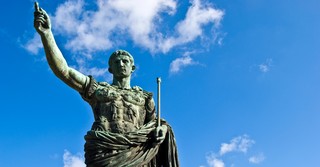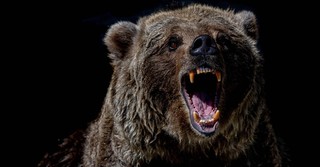4 Examples of Powerful Symbolism in the Book of Daniel
Share

Like other prophetic books of the Bible, Daniel confounds many readers. What are we to make of the strange visions and dreams? Is there any way to identify the odd – even frightening – images described by Daniel?
A person’s approach to biblical interpretation will influence how they explain the odd creatures and other forms of symbolism present in this book of the Bible. Some may focus on interpretations involving the past or future, or as allegory meant to convey spiritual truth. What all believers can acknowledge, however, is that the symbols in Daniel have powerful meanings. They teach significant truths about the Lord’s sovereignty and plan, for He remains the ultimate Ruler despite the rise and fall of empires and earthly kings.
The following examples provide a glimpse at what these images from dreams and visions can teach us, not only about the past or future, but also about the Lord God and His Kingdom.
Photo credit: ©Getty Images/johan63

1. The Great Statue
When Nebuchadnezzar had a dream and the wise men of the kingdom could not tell him his dream or its interpretation, he ordered all the wise men to be killed, including Daniel and his friends (Daniel 2:12-13). These Jewish exiles prayed urgently to the Lord, asking for His help (Daniel 2:17-18). God answered. Daniel was able to not only describe the dream but provide the interpretation too, since the Lord had revealed the meaning to him.
Within Nebuchadnezzar’s dream was the image of a great statue, “mighty and of exceeding brightness” (Daniel 2:31). This statue appeared as a man with a gold head, a silver chest and arms, a belly and thighs of bronze, iron legs with feet made of a mix of iron and clay (Daniel 2:31-35). As formidable and impressive as this statue appeared, it was struck by a rock and destroyed. Nothing was left of the statue. Instead, the rock “became a huge mountain and filled the whole earth” (Daniel 2:35).
As Daniel explained to Nebuchadnezzar, the statue symbolized kingdoms of the earth (Daniel 2:37-43). Interestingly, the image is that of a man, which correlates with the prophecies concerning the kingdoms of men. The gold head represented Nebuchadnezzar and the Babylonian empire. Perhaps this is why the king decided soon after this event to create a golden image for people to worship (Daniel 3:1-6). He was the golden head after all – ruler of a vast number of peoples and places.
Many commentators view the other kingdoms this way:
Silver represented the Medes and Persians (Daniel lived through the overthrow of the Babylonian empire and served under Darius and Cyrus)
Bronze represented the empire of the Greeks
Iron symbolized the Roman empire which was eventually weakened by its lack of unity, shown through the mixing of clay and iron in the feet of the statue.
Though some are critical that Daniel could have prophesied about kingdoms that did not yet exist, Scripture testifies that the prophecy came from the Lord (Daniel 2:20-23). Daniel did not manufacture the explanation; it was given to Him by God.
The central event in this dream, though, is that a rock will destroy the impressive statue of the man so that it crumbles and gets blown away like chaff in the wind (Daniel 2:35). Believers will quickly recognize that this rock, which turns into the mountain covering the earth, is the Lord Jesus. For His Kingdom will last forever (Daniel 2:44; also see Isaiah 9:7 and Luke 1:33).
As powerful as the empires of men may seem, our Lord is stronger than all. Nothing can or ever will stop His Kingdom from coming.
Photo credit: ©Getty Images/Jule_Berlin

2. Nebuchadnezzar’s Dream of the Tree
Nebuchadnezzar’s other dream was that of a large tree with long branches that provided shelter for the animals and birds of the earth. Everyone prospered because of its shade and fruit (Daniel 4:10-12). But the tree’s days were cut short when a holy messenger ordered for the tree to be chopped down, and the stump covered in iron and bronze (Daniel 4:13-17). The stump would then be exposed to the elements and given the mind of a beast for seven years (Daniel 4:15-16).
That tree symbolized Nebuchadnezzar, as Daniel explained. He had grown into a king with great power that affected many people on earth. With this power, though, came the swelling of pride. To humble this king and remind him of who was truly sovereign and mighty, God would strip Nebuchadnezzar of his power and force him to wander like an animal for seven years. All of this happened exactly as Daniel prophesied.
The king boasted of his kingdom, which he claimed he built through his own might and for his glory (Daniel 4:30). Because of this, the Lord sent him out to live like a beast for the appointed time, in apparent insanity (Daniel 4:33).
Nebuchadnezzar learned his lesson and was humbled from this experience. He glorified God and declared, “His dominion is an eternal dominion; his kingdom endures from generation to generation. All the peoples of the earth are regarded as nothing. He does as he pleases with the powers of heaven and the peoples of the earth. No one can hold back his hand or say to him: ‘What have you done?’” (Daniel 4:34-35).
Through the symbolism of the tree, we see the power of God to humble the proud (Daniel 4:37). Like other kings before him, including the king of Assyria and Pharoah of Egypt, Nebuchadnezzar had viewed himself as a mighty force in the world, a god among men (see Ezekiel 31). But those trees fell, as will all others that become too lofty. Governments, kings, and other authorities may think they are sovereign and answer to no one. They forget, until perhaps when they are humbled, that there is a Lord in heaven who is above all. He is the One who sets people in places of authority.
And His Kingdom is not like theirs, for His is like the mustard seed that started small and grew to become a great tree that all the birds nested in (Matthew 13:31-32; Luke 13:18-19). That tree, or Kingdom, will never be cut down.
Photo credit: Unsplash/Annie Spratt

3. Daniel and the Four Beasts
Nebuchadnezzar was not the only one to have a dream. Daniel also dreamed and had a vision of four beasts. He saw four frightening animals: a lion with wings of an eagle, a bear holding three ribs in its mouth, a leopard with four heads and four wings, and a beast with iron teeth and ten horns, and later a little horn grew among the others (Daniel 7:4-8). Scripture informs us that these beasts will eventually be stripped of their power as they stand in judgment before the Ancient of Days (Daniel 7:9-12).
Upon our first encounter with this description, we were probably disturbed and confused like Daniel. But thankfully he sought out an explanation, which an angel provided. Similar to Nebuchadnezzar’s dream of the great statue, the four beasts represent four kingdoms and kings (Daniel 7:17, 23-24).
Instead of precious metals, Daniel’s dream involved animals. The lion that has its wings stripped and made to stand to receive the mind of a man is the Babylonian kingdom. The bear holding the three ribs is the kingdom of the Medes and Persians. The leopard with four heads and wings of a bird is the Greek empire. And, the odd beast that caught Daniel’s attention, which is described as having horns and iron teeth, corresponds to the great Roman empire.
Where commentators disagree is over the identity of the ten kings and the little horn with a boastful mouth. Some argue that these correspond to kings in history. However, others view these as future rulers, especially the little horn who will speak against the Lord and oppress the saints. Interestingly, this little horn is part of the beast that will be slain and cast into “blazing fire” similar to the beast in Revelation (Daniel 7:11; compare to Revelation 19:20). Based on the other descriptions in Daniel and passages in the New Testament, many scholars view this little horn as the Antichrist.
As terrifying and powerful as these beasts appeared, especially the fourth one, their end is certain. The angel assured Daniel: “The four great beasts are four kings that will rise from the earth. But the holy people of the Most High will receive the kingdom and will possess it forever — yes, for ever and ever” (Daniel 7:17-18). Though the holy people, or saints of the Lord, will be hunted and oppressed by the little horn of the beast with the iron teeth, they will overcome because the Son of Man is the true Ruler (Daniel 7:13-14). All will bow down before Jesus and His rule will never end (also see Philippians 2:10-11).
We could easily get lost in the specifics of interpretive approaches and eschatological views. However, what all believers can agree on regarding the symbolism of these four beasts is that they represent kingdoms of the earth – ones that are formidable and hold great authority, but which will not last forever. Nothing can prevail against the Kingdom of Christ.
Photo credit: Unsplash/mana5280

4. The Ram and Goat
About two years after his dream of the four beasts, Daniel had another vision. This time, he saw a ram with two horns, one longer than the other (Daniel 8:1-4). The ram’s dominion extended from west, to north, to south. However, Daniel also saw a goat with one large horn that came from the west (Daniel 8:5). This goat fought and defeated the ram, shattering the ram’s two horns (Daniel 8:6-7). As this goat increased in strength and prestige, though, his horn was shattered and replaced with four horns (Daniel 8:8). From these horns also came a little horn that grew to the south, east, and toward “the Beautiful Land” (Daniel 8:9).
This same horn grew so high that it knocked stars from heaven and trampled them (Daniel 8:10-11). In pride, the horn set itself above the Prince of the host of heaven and abolished the sacrifice of the temple. Though it will succeed in what it sets out to do, this little horn will not honor or uphold the truth (Daniel 8:12).
Thankfully, Gabriel explained the symbolism of this vision to Daniel so that we do not have to grapple to piece together the strange images. The ram referred to the Medes and Persians who would be defeated by the goat, the kingdom of Greece (Daniel 8:19-22). The goat’s single horn represented one king of the Greeks, while the four horns refer to four kingdoms. The little horn in this vision symbolized “an insolent king” (Daniel 8:23, HCSB).
Most commentators agree that the single horn of the goat was symbolic of Alexander the Great, and the four horns that came after were four succeeding kings. The little horn of this chapter was Antiochus IV Epiphanes, known for his persecution of the Jewish people and the defilement of the temple. To this day, the Jews celebrate Hanukkah to remember the Maccabean Revolt against Antiochus and the restoration of the temple.
Antiochus’ blasphemous actions and persecution of God’s chosen people serve as a foreshadowing of what the other little horn of Daniel 7, the Antichrist, will do in the last days. He, too, will abolish the sacrifices in the temple and seek to destroy the Jewish people (see 2 Thessalonians 2:4; Revelation 13:6-7).
Yet, even among these words of fulfilled prophecy, we receive another reminder that the kings of the earth do not have the ultimate authority. Antiochus IV was cruel and powerful. However, the days of that insolent king were brought to end. As Gabriel explained, “he shall be broken — but by no human hand” (Daniel 8:25). God cut down that prideful horn, just as He will do in the future to the Antichrist and any other nation that rises against Him (Revelation 19:15).
Woven throughout the book of Daniel, and the powerful symbolism contained within, is the theme that the Lord is sovereign, and His Kingdom is eternal. All other kingdoms and kings will have to bow to the One who is Lord and King of all.
Photo credit: Unsplash/Peter Neumann
